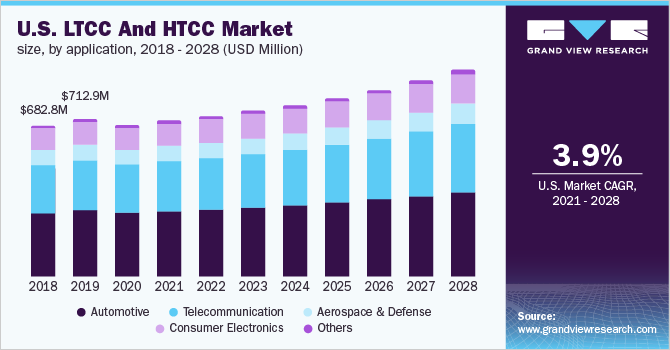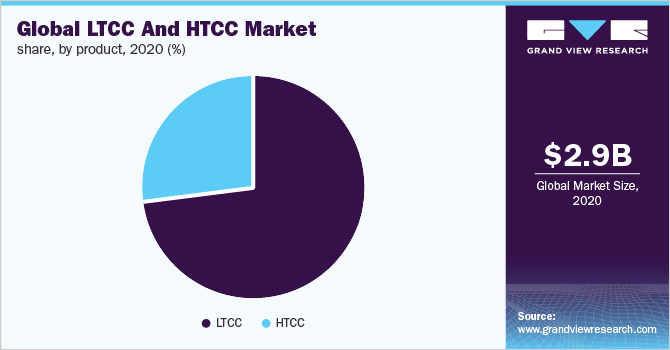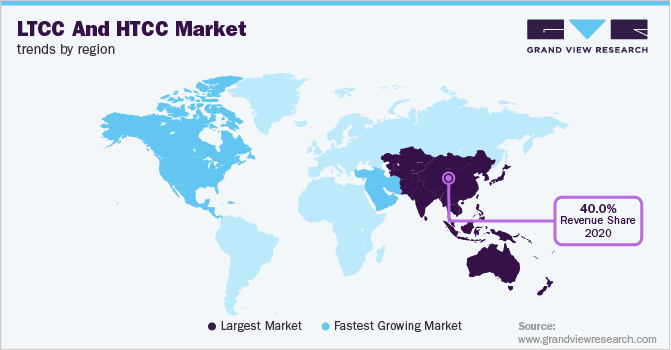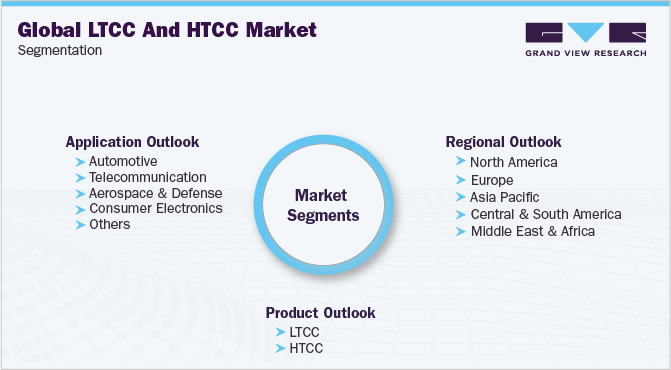- Home
- »
- Specialty Glass, Ceramic & Fiber
- »
-
LTCC And HTCC Market Size Report, 2021-2028GVR Report cover
![LTCC And HTCC Market Size, Share & Trends Report]()
LTCC And HTCC Market Size, Share & Trends Analysis Report By Product (LTCC, HTCC), By Application (Automotive, Telecommunication, Aerospace & Defense, Consumer Electronics), By Region, And Segment Forecasts, 2021 - 2028
- Report ID: GVR-4-68038-592-2
- Number of Pages: 102
- Format: Electronic (PDF)
- Historical Range: 2017 - 2019
- Industry: Advanced Materials
Report Overview
The global LTCC and HTCC market size to be valued at USD 3.9 billion by 2028 and is expected to grow at a compound annual growth rate (CAGR) of 3.5% during the forecast period. The growing requirement of microelectronics in vehicles and aircraft for a safer experience is anticipated to drive market growth over the forecast period. LTCC and HTCC ceramic substrates are widely used in numerous industries such as automotive, telecommunication, and consumer electronics. Rising concerns to develop high-performance small-sized circuit boards for electronic components at low manufacturing costs are likely to drive the growth of the market over the coming years.

The U.S. is expected to remain the leading market for LTCC and HTCC in North America over the forecast period owing to the growing prominence of emerging technologies such as the Internet of Things (IoT) and 5G technology. Rising research spending for developing next-generation wireless technologies and ongoing collaborations among different research institutes are projected to further fuel market growth. Furthermore, increasing penetration of electronic devices/sensors in vehicles is anticipated to offer new avenues for the growth of the market in the coming years. For instance, LTCC offers superior performance in advanced automotive sensing, and HTCC technology can be utilized for next-generation automotive components such as the packaging of LED headlights, LD headlights, and DCB circuit substrates.
With the shifting transition from hardware to software-defined vehicles, market players across the value chain of automotive electronics are investing to capitalize on innovations through software and electronics. Examples of software innovation include connectivity, electrification, autonomous driving, and diverse mobility. LTCC is an attractive solution for the packaging of microelectronic devices, however, numerous studies are underway to overcome challenges encountered during the production, processing, and application of LTCC. These challenges include chemical issues, which arise due to the interaction of thick films and glass phases in tapes, whereas physical issues arise due to the mismatch of screen-printed paste and tape.
LTCC And HTCC Market Trends
The growing trend of using digital platforms in daily life has fuelled the demand for telecommunication products in the forecast period. Moreover, the rise in investments in the automotive and aerospace industries are proving beneficial to market growth since the LTCC substrates are widely used in various airplane and fighter jets.
Ceramic substrates such as LTCC and HTCC are widely used in a variety of industries, including automotive, telecommunications, and consumer electronics. Growing concerns about producing advanced small-sized circuit boards for electrical components at low production costs are expected to drive market growth in the coming years.
Fewer reparability concerns regarding LTCC and HTCC applications hamper the market growth. However, the rising demand for nanotechnology and powerful processing systems has offered new opportunities for the markets. New opportunities will emerge as different companies develop advanced LTCC technologies, allowing these companies to grow their position in the 5G space.
LTCC is an appealing solution for small electronic device packaging. Various studies are ongoing to overcome the challenge encountered during LTCC production, processing, and application.
Application Insights
The automotive segment held the largest revenue share of over 42.0% in 2020. LTCC and HTCC are used in automotive electronics for a safer and enhanced driving experience. The inclination of consumers toward the safety of vehicles, adoption of telematics, and government-defined safety norms are the prominent factors driving the demand for automotive electronics. Key applications of automotive electronics include Advanced Driver Assistance Systems (ADAS), safety, powertrain, and infotainment. These applications have created a need for microcontrollers, actuators, processors, and sensors, which, in turn, are expected to augment market growth.
Telecommunication is another key application segment. Radio, microwaves, and millimeter waves are used for wireless communication. The penetration of LTCC technology is rapidly increasing for applications in microwave and millimeter-wave frequency band in areas including Bluetooth module, front end module of mobile phones, and WLAN. Moreover, new opportunities lie ahead as various companies are developing advanced LTCC products, which are projected to benefit these companies to expand their footprint in 5G communication. For instance, in October 2021, Nippon Electric Glass Co., Ltd. announced an improvement in characteristics of the LTCC materials portfolio, which can be used in devices and components for 5G communication.
Product Insights
Based on product, the LTCC segment accounted for the largest revenue share of more than 73.0% in 2020. The high share of LTCC can be attributed to its properties such as higher operating temperature, excellent thermal properties, lower expansion coefficient, high reliability, and integration density. Rising demand for high-speed internet in urban and semi-urban locations is increasing investments in wireless technologies and RF modules, which is anticipated to propel LTCC demand. For instance, in October 2019, Murata Manufacturing Co., Ltd. announced to develop RF modules solution for Terragraph, which is the wireless technology of Facebook. The RF modules use LTCC products for stable communication quality.

HTCC is an older technology used in manufacturing ceramic PCBs. Its advantages include chemical stability, lower material costs, high heat dissipation coefficient, high mechanical strength, and high wiring density. HTCC components usually consist of multilayers of zirconia or alumina with tungsten, platinum, and moly manganese metallization. In addition, in HTCC the sintering temperature is higher as compared to LTCC. However, compared to other manufacturing technologies, HTCC is older. Some of its drawbacks include high production cost and low conductivity.
Regional Insights
Asia Pacific held the largest revenue share of 42.0% in 2020 owing to the rapidly flourishing automotive, consumer, and industrial electronics sectors in countries such as India, China, South Korea, and Japan. The ongoing incentive schemes for EVs by governments of different countries are anticipated to attract auto-electronic product manufacturers to the region. Furthermore, with the advent of 5G technology, China is witnessing investments in its power electronics industry, which is anticipated to benefit market growth. For instance, in June 2020, Panasonic announced plans to enhance its production of 5G circuit board components in China and invest a sum of USD 75 million (CNY 8 billion) for expanding its plant in Guangzhou.

In North America, the market is anticipated to register a CAGR of 3.8%, in terms of revenue, over the forecast period. The growth of the market in this region can be attributed to the rising demand for LTCC based PCBs and the flourishing wireless communication industry in the region. In Europe, market growth is attributed to the development of the EV industry. In 2020, Europe exceeded China and became the largest EV market. With 1.4 million EVs sold, the region held a revenue share of 45.0% of EV sales in 2020. Growth in the EV industry will augment demand for auto electronics and positively influence product demand over the forecast period.
Key Companies & Market Share Insights
The global LTCC and HTCC market is characterized by strong competition owing to the presence of prominent substrate manufacturers serving major geographies across the globe. These manufacturers compete based on product quality and price to increase the application scope of the product in industries including automotive, telecommunications, healthcare, aerospace, and others. Technical innovations and improvements in the production process have resulted in the production of LTCC and HTCC substrates that enable high durability, miniaturization, and integration across components. Market players are increasingly investing in R&D in order to achieve a strong hold in the competition by offering advanced LTCC products at competitive prices.
Recent Developments
-
In April 2022, KYOCERA Corporation developed transmissive metasurface technology to enhance the range and performance of 5G and 6G networks by directing wireless network signals in a particular fashion. The shareable meta surface further helps in transmit the high-frequency 5G and 6G to areas where connection is slow.
-
In August 2021, Mini-Circuits created a new set of filters based on LTCC technology for the millimetre wave 5G market 1. A patent was also granted to the corporation for the same.
Some of the prominent players in the LTCC and HTCC market include:
-
Hitachi Metals Ltd.
-
Kyocera Corporation
-
Murata Manufacturing Co., Ltd.
-
TDK Corporation
-
NGK Spark Plug Ltd.
-
Yokowo Co., Ltd.
-
KOA Corporation
-
Maruwa Co. Ltd.
LTCC And HTCC Market Report Scope
Report Attribute
Details
Market size value in 2021
USD 3.0 billion
Revenue forecast in 2028
USD 3.9 billion
Growth Rate
CAGR of 3.5% from 2021 to 2028
Base year for estimation
2020
Historical data
2017 - 2019
Forecast period
2021 - 2028
Quantitative units
Revenue in USD million and CAGR from 2021 to 2028
Report coverage
Revenue forecast, competitive landscape, growth factors, company market ranking, and trends
Segments covered
Product, application, region
Regional scope
North America, Europe, Asia Pacific, Central & South America; MEA
Country scope
U.S.; Germany; U.K.; France; China; India; Japan; Brazil
Key companies profiled
Hitachi Metals Ltd.; Maruwa Co. Ltd.; KOA Corporation; TDK Corporation; Kyocera Corporation
Customization scope
Free report customization (equivalent up to 8 analysts working days) with purchase. Addition or alteration to country, regional, and segment scope.
Pricing and purchase options
Avail customized purchase options to meet your exact research needs. Explore purchase options.
Global LTCC And HTCC Market SegmentationThis report forecasts revenue growth at the global, regional, and country levels and provides an analysis of the latest industry trends in each of the sub-segments from 2017 to 2028. For the purpose of this study, Grand View Research has segmented the global LTCC and HTCC market report on the basis of product, application, and region:

-
Product Outlook (Revenue, USD Million, 2017 - 2028)
-
LTCC
-
HTCC
-
-
Application Outlook (Revenue, USD Million, 2017 - 2028)
-
Automotive
-
Telecommunication
-
Aerospace & Defense
-
Consumer Electronics
-
Others
-
-
Regional Outlook (Revenue, USD Million, 2017 - 2028)
-
North America
-
U.S.
-
-
Europe
-
Germany
-
U.K.
-
France
-
-
Asia Pacific
-
China
-
India
-
Japan
-
-
Central & South America
-
Brazil
-
-
Middle East & Africa
-
Frequently Asked Questions About This Report
b. The LTCC and HTCC market size was estimated at USD 2.9 billion in 2020 and is expected to reach USD 3.0 billion in 2021.
b. The LTCC and HTCC market is expected to grow at a compound annual growth rate of 3.5% from 2021 to 2028 to reach USD 3.9 billion by 2028.
b. Based on the application segment, automotive held the largest revenue share of 42.0% in 2020 owing to the increasing penetration of automotive electronics to achieve a safer and enhanced driving experience.
b. The key players operating in the LTCC and HTCC market include Hitachi Metals Ltd, KOA Corporation, Kyocera Corporation, TDK Corporation, NGK Spark Plug Ltd., Maruwa Co. Ltd., and Murata Manufacturing Ltd.
b. The growing demand for automotive electronics coupled with rising investments in the wireless communication technology are the growth drivers for the LTCC and HTCC market.
Share this report with your colleague or friend.
![gvr icn]()
NEED A CUSTOM REPORT?
We can customize every report - free of charge - including purchasing stand-alone sections or country-level reports, as well as offer affordable discounts for start-ups & universities. Contact us now
![Certified Icon]()
We are GDPR and CCPA compliant! Your transaction & personal information is safe and secure. For more details, please read our privacy policy.
We are committed towards customer satisfaction, and quality service.
"The quality of research they have done for us has been excellent."





